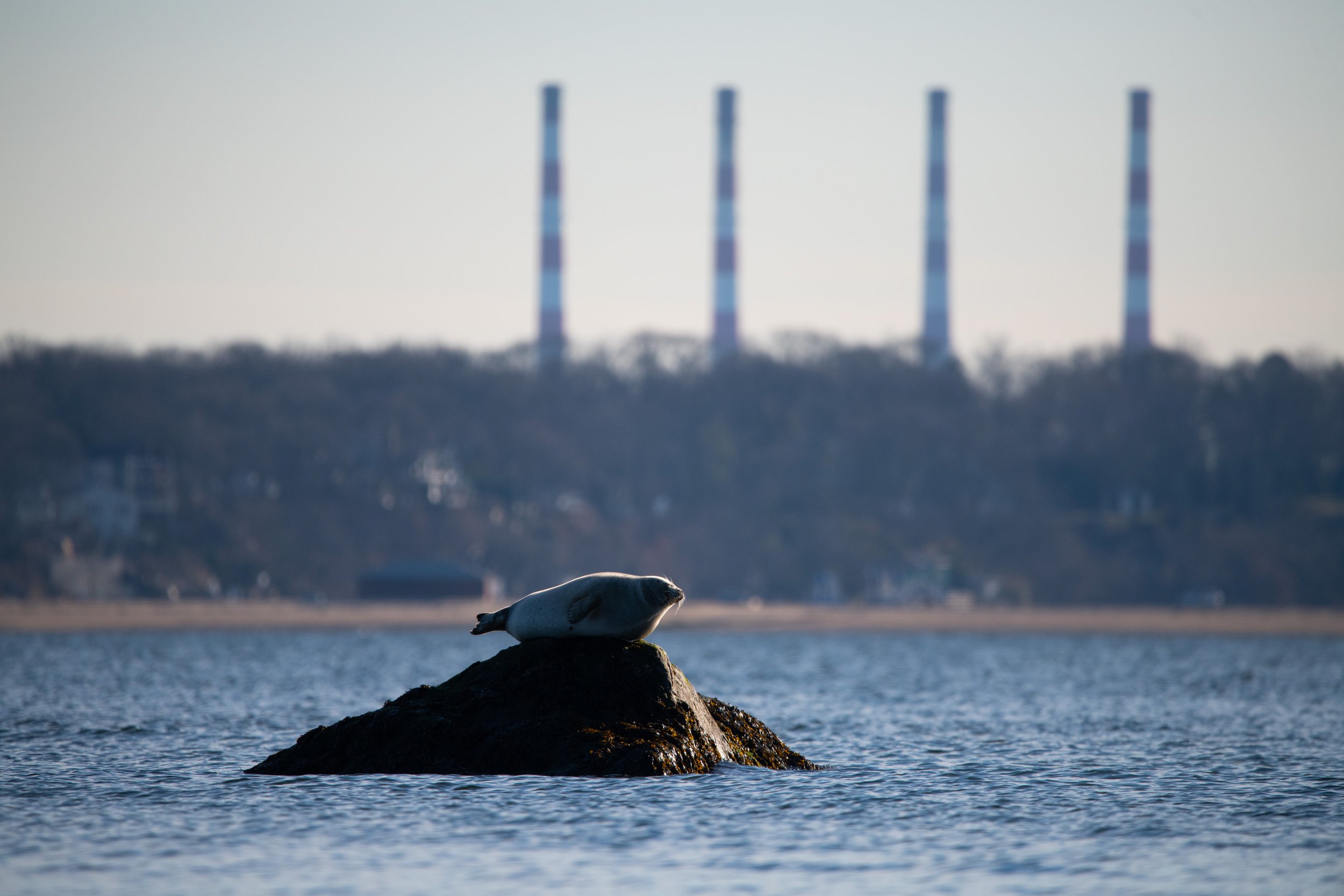The Energy Transition and Marine Wildlife
Above: A harbor seal on the north shore of Long Island silhouetted against the Northport power station in the distance, exemplifying the balance that human industry shares with our local marine life.
A deceased humpback whale washed up on the south shore of Long Island this past Monday, sparking discussions amongst residents about the impact that energy generation is having on our marine life. There is a belief that offshore wind farm development is disrupting the life of marine mammals. But at this time, there is not enough science to support that claim.
Is it possible? Of course. The number of humpback whale strandings on the east coast has been increased since 2016, according to NOAA. It is worth noting that 40% of the 180 stranded whales reported had signs of ship strikes or fishing equipment entanglement. And it is also worth mentioning that development of wind farms in New York only started about a year ago in February of 2022.
The Northport power station in the above photo generates electricity using fuel oil and natural gas. By 2027, the governor of New York wants fossil fuels to be completely phased out for new construction in exchange for an entirely electric grid, with 70% of the electricity coming from renewable energy by 2030. Perhaps a power station from the 1970s is not the most efficient way to generate our electricity. Does offshore wind give us a better alternative?
In terms of energy, yes. The two in-progress wind projects would supply the area with more megawattage than one vintage power station alone would. The currently contracted projects, Empire Wind 2 and Beacon Wind, have the capacity to add 2,490 megawatts of energy to the power grid by the time of their commissioning in 2027. In contrast, the Northport power station has a capacity of 1,516 megawatts, and the station rarely runs at capacity due to its advanced age.
When it comes to direct impacts on the environment, the typical power station is not free of blame. The Northport plant is cooled with water that is withdrawn from the Long Island Sound and then
discharged directly back into the same body of water, unnaturally warming the discharge areas with thermal pollution and disrupting the natural ecosystem. The same cooling system contributes to fish mortality, where fish eggs or the animals themselves become entrapped in the filters of the system. In addition, the search for and extraction of oil and natural gas used in the Northport power plant permanently fragments wildlife habitats, disrupts migration routes, and changes ecosystem dynamics, particularly in the ecologically-diverse western Canada where the natural gas used at Northport originates. And we can’t forget the basics - the release of methane from the burning of fossil fuels directly contributes to global climate charge.
But offshore wind is not without its concerns. There is the fear that birds and bats will be disrupted, injured, or killed by wind turbines. The biggest concern bubbling over on Long Island and New Jersey lately is that sound-sensitive animals like whales and dolphins will be displaced, injured, or unable to communicate properly due to the sound of construction during offshore wind farm installations, despite a lack of evidence of this impact thus far. The possibility of increased boat-strike risk to all wildlife during periods of construction and human activity is also a concern. But there are responsible actions that can be taken to mitigate risk. For example, Professor Charles Peterson of UNC Chapel Hill recommended painting wind mills in high-contrast patterns, which makes birds such as kestrels more likely to avoid them. And NOAA regulates speed restrictions for all vessels related to offshore wind development to keep wildlife safe from boat strikes.
Despite a lack of evidence, and after confirmation by NOAA and the offshore wind developers that there has been no impact on whales, officials along the east coast are calling for a stop to offshore wind preparations.
We are coming upon a major energy transition. Will the phasing out of fossil fuels positively impact our local wildlife? Without a doubt. Can we develop renewable energy in a responsible way that won’t impact the same local wildlife? So far, the signs are pointing to yes, but with more research needed. I don’t know that we can make any conclusions about renewable energy development without examining the impacts we have not been able to see yet. What I do know is that prematurely stopping the transition into our renewable energy future would be detrimental in the realm of progress. Being responsible stewards to our environment should be a major priority in this transition forward, and that can only be done by looking at science and facts.
